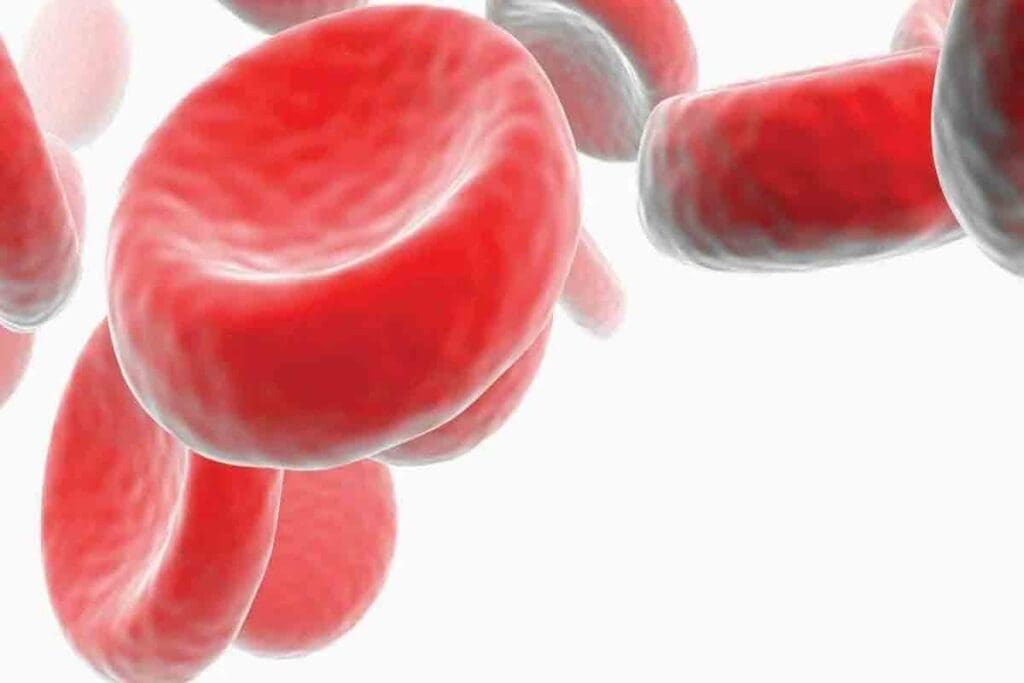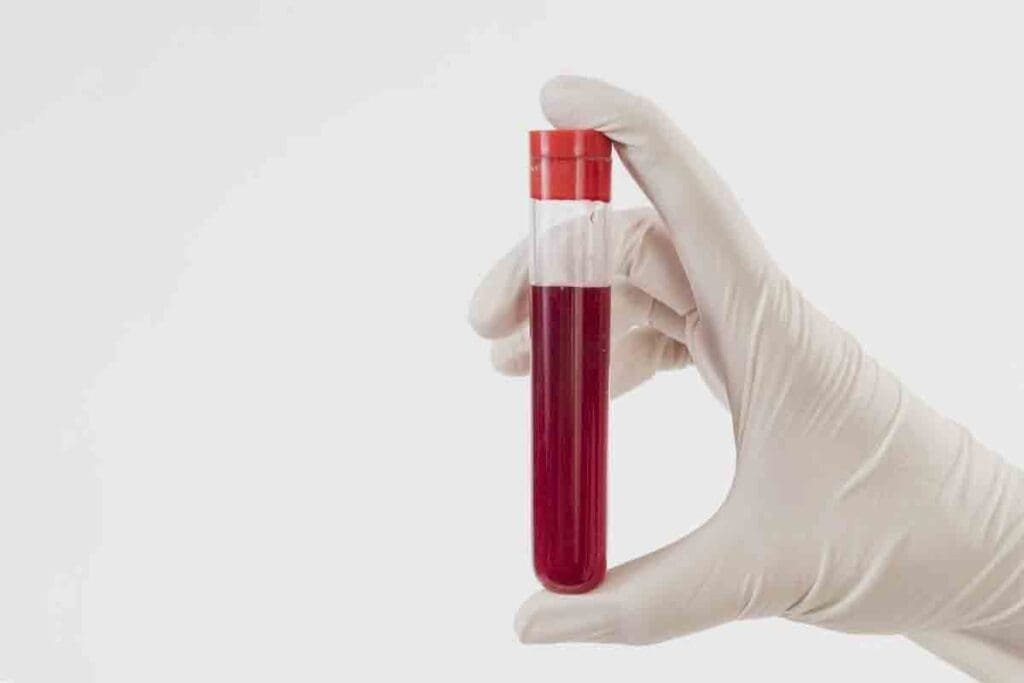Last Updated on November 20, 2025 by Ugurkan Demir

Aplastic anemia is a rare and serious disease. It happens when the bone marrow can’t make enough blood cells. This leads to pancytopenia and can cause a lot of health problems and even death. Getting the diagnosis right is key to treating it well. Get the diagnostic criteria for aplastic anemia. Learn about 7 essential tests and laboratory findings for this serious diagnosis.
At Liv Hospital, we use our trusted knowledge and care for patients to help doctors diagnose this tough condition. The diagnostic process includes looking at how the patient feels, lab tests, blood smear results, and bone marrow samples.
It’s important for doctors to know the signs of aplastic anemia to treat it correctly. We’ll explain the seven main steps doctors follow to make this diagnosis.

It’s important to understand aplastic anemia to diagnose and treat it. This condition happens when the bone marrow fails to make enough blood cells. This failure leads to a lack of all types of blood cells.
Aplastic anemia is when the bone marrow can’t make enough blood cells. This results in a lack of all blood cell types. It can be caused by autoimmune disorders, chemicals, or viruses.
The bone marrow fails because of an immune attack. T cells destroy the stem cells needed to make blood. This makes the bone marrow empty and reduces blood cell production.
Aplastic anemia’s rate varies worldwide, from 0.6 to 6.1 cases per million people each year. It mostly affects people in their 20s and 30s, and also the elderly.
Exposure to chemicals, certain drugs, and viruses can increase the risk. Genetic conditions like Fanconi anemia also play a role.
| Risk Factor | Description |
| Chemical Exposure | Pesticides, solvents, and other toxic substances |
| Medications | NSAIDs, antibiotics, and certain other drugs |
| Viral Infections | Hepatitis, HIV, and other viral infections |
| Genetic Conditions | Fanconi anemia and other genetic disorders |
People with aplastic anemia often feel tired, weak, and short of breath. They may also get infections and bleed easily.
The symptoms can vary based on how severe the condition is. Some may not show symptoms at first, while others may have serious problems.
Aplastic anemia is serious and needs quick diagnosis and treatment. Knowing about its causes, how common it is, and its symptoms helps doctors treat it well.

The way we diagnose aplastic anemia has changed. Now, we use new criteria and classifications. To diagnose aplastic anemia, doctors look at symptoms, lab tests, and bone marrow biopsies.
At first, doctors mainly used symptoms and simple lab tests to diagnose aplastic anemia. But, as we learned more about the disease, our diagnostic tools got better.
A leading hematologist said, “Our better understanding of aplastic anemia has led to new diagnostic standards.”
“Diagnosing aplastic anemia is not just about finding pancytopenia. It’s about understanding the causes and risks.”
It’s important to tell aplastic anemia apart from other bone marrow problems. We look for pancytopenia, low bone marrow cells, and no abnormal cells.
| Disease | Pancytopenia | Bone Marrow Cellularularity | Abnormal Cells |
| Aplastic Anemia | Present | Hypocellular | Absent |
| Myelodysplastic Syndromes | Present | Normocellular or Hypercellular | Present |
| Paroxysmal Nocturnal Hemoglobinuria | Variable | Variable | Present (Clonal cells) |
We classify aplastic anemia by how severe it is. The Camitta criteria help us do this. They divide it into severe, very severe, and non-severe.
Camitta Criteria for Severity Classification:
Knowing these criteria and systems is key for doctors. It helps them give the right diagnosis and treatment plans for aplastic anemia patients.
The complete blood count is a key tool for diagnosing suspected aplastic anemia. It shows the patient’s blood cell counts. This helps doctors spot pancytopenia, a sign of the disease.
Pancytopenia means all three main blood cell types are low. This is a big clue for aplastic anemia. How low each type is can tell doctors a lot.
Doctors look at how much each blood cell type is reduced. Aplastic anemia often shows:
Hemoglobin levels are very important in the CBC. In aplastic anemia, hemoglobin is often very low. This shows anemia. The level of anemia can be mild, moderate, or severe.
| Hemoglobin Level (g/dL) | Severity of Anemia |
| 10-12 | Mild |
| 8-10 | Moderate |
| <8 | Severe |
Knowing these levels helps doctors understand how severe anemia is. This guides their treatment plans.
The CBC also shows platelet and neutrophil counts. In aplastic anemia:
The level of thrombocytopenia and neutropenia shows how severe aplastic anemia is. By looking at these counts, doctors can understand the patient’s condition well. They can then plan the best treatment.
When we look into aplastic anemia, a detailed analysis of the peripheral blood smear is key. This tool gives us insights into blood cell shapes, helping us diagnose and tell apart aplastic anemia from other pancytopenia causes.
The peripheral blood smear in aplastic anemia shows a drop in all main cell types, known as pancytopenia. Normocytic anemia is common, with lower hemoglobin levels. It also shows fewer reticulocytes, showing the bone marrow can’t make enough red blood cells.
Also, the smear analysis looks at the shape of the cells left. In aplastic anemia, these cells look normal but are fewer in number. This is key in telling aplastic anemia apart from other bone marrow failure syndromes.
The reticulocyte count is a key part of diagnosing aplastic anemia through the peripheral blood smear. A low count with anemia points to a failing bone marrow, a sign of aplastic anemia. The absolute reticulocyte count is even more precise, showing how well the bone marrow works.
We check the reticulocyte count to see if the bone marrow can make new red blood cells. In aplastic anemia, this count is usually low, showing the bone marrow can’t keep up with the demand for red blood cells.
Not seeing abnormal cells in the peripheral blood smear is also a key finding in aplastic anemia. The absence of blasts or dysplastic cells helps us rule out other myelodysplastic syndromes or acute leukemias.
In figuring out what’s behind aplastic anemia, we look at other reasons for pancytopenia like myelodysplastic syndromes, acute leukemia, and bone marrow infiltration. The peripheral blood smear, along with other tests, helps us narrow down the possible causes and make a clear diagnosis.
For aplastic anemia, bone marrow biopsy is the top choice for diagnosis. It lets us check the bone marrow’s health and confirm the diagnosis.
Bone marrow biopsy can be done in two ways: aspiration or trephine. Aspiration shows the marrow’s cell types. Trephine gives a detailed look at the marrow’s structure.
Trephine biopsy is key to diagnosing aplastic anemia. It helps see how many cells are in the marrow and if there are any problems.
A key sign of aplastic anemia is hypocellularity. This means there are fewer cells in the bone marrow. Knowing how much is missing is important for diagnosis and understanding how severe it is.
| Cellularity | Description | Clinical Significance |
| Normal | 50-70% cellularity | Normal bone marrow function |
| Mild Hypocellularity | 30-50% cellularity | Mild reduction in marrow function |
| Moderate Hypocellularity | 10-30% cellularity | Significant reduction in marrow function |
| Severe Hypocellularity | Severe aplastic anemia, high risk of infections and bleeding |
The marrow in aplastic anemia looks very different. It’s mostly empty, without any signs of abnormal growth or damage. We look for these signs to tell aplastic anemia apart from other conditions.
Looking at histological features like fat buildup and fewer cells is key. These signs help us see how damaged the marrow is and guide treatment.
In diagnosing aplastic anemia, cytogenetic and molecular testing are key. They help find chromosomal and genetic changes.
These tests give insights into aplastic anemia’s genetic makeup. This helps doctors understand the disease better and choose the right treatments.
Cytogenetic testing looks at chromosomes for abnormalities linked to aplastic anemia. It uses karyotyping and FISH.
Some patients with aplastic anemia have chromosomal changes. These changes can affect how the disease progresses and how well it responds to treatment.
| Chromosomal Abnormality | Clinical Significance |
| Trisomy 8 | Associated with a higher risk of disease progression |
| Monosomy 7 | Often linked with a poorer prognosis |
| Complex karyotype | May indicate a higher risk of treatment failure |
Molecular testing looks for genetic mutations in aplastic anemia. Next-generation sequencing (NGS) is used to find mutations in genes related to bone marrow failure.
This screening helps find inherited aplastic anemia, like Fanconi anemia. It guides treatment choices.
Cytogenetic and molecular testing track clonal evolution in aplastic anemia. Clonal evolution means new clones with different genes appear.
Tracking this is key to understanding how the disease progresses. It helps find new treatment targets.
By using these tests together, doctors get a full picture of aplastic anemia. This leads to more tailored treatments for patients.
To accurately diagnose aplastic anemia, we use specialized tests. These tests help us tell it apart from other bone marrow failure syndromes. They are key in finding conditions that might look like or be linked to aplastic anemia.
Paroxysmal nocturnal hemoglobinuria (PNH) is a rare and serious blood disease. It causes red blood cell destruction, bone marrow failure, and blood clots. Flow cytometry is used to find cells missing certain proteins in PNH.
PNH often goes hand in hand with aplastic anemia. Research shows that many aplastic anemia patients also have PNH. This overlap is important to note.
Fanconi anemia (FA) is a genetic disorder that leads to bone marrow failure and other issues. It’s vital to screen for FA, mainly in young patients or those with a family history.
Diagnosing FA involves chromosomal breakage tests and genetic analysis. Finding FA early can help manage the condition and may lead to bone marrow transplantation.
Viral infections can make the bone marrow stop working, similar to aplastic anemia. So, viral serology tests are key in making a correct diagnosis.
| Virus | Test | Significance |
| Hepatitis viruses | Serology for hepatitis A, B, and C | Hepatitis viruses can cause bone marrow suppression |
| Epstein-Barr virus (EBV) | EBV IgM and IgG antibodies | EBV infection can cause hematologic abnormalities |
| Cytomegalovirus (CMV) | CMV IgM and IgG antibodies | CMV can reactivate in immunocompromised patients |
Using these specialized tests helps us accurately diagnose aplastic anemia. This way, we can offer the right treatment plans for our patients.
A bone marrow biopsy is key to diagnosing aplastic anemia. But, imaging studies add extra info for treatment plans. They check for other issues that might affect treatment.
X-rays and CT scans give insights into aplastic anemia. They look for bone problems or other issues.
Key uses of radiological assessment include:
Ultrasound is useful in managing aplastic anemia. It checks spleen size and finds related issues.
| Imaging Modality | Primary Use in Aplastic Anemia | Benefits |
| X-ray | Bone density assessment | Quick, widely available |
| CT Scan | Detailed bone and soft tissue evaluation | High-resolution images, useful for detecting complications |
| Ultrasound | Spleen size assessment, detecting abnormalities | Non-invasive, no radiation exposure |
Techniques like MRI give detailed views of bone marrow. MRI can tell aplastic anemia apart from other conditions by looking at marrow cellularity and fat.
These imaging studies help, even if they’re not the main way to diagnose aplastic anemia. They give important information for managing the disease. By combining imaging with clinical and lab data, doctors can better understand and treat the condition.
Clinical decision-making in aplastic anemia is improved by using diagnostic algorithms. These tools help us make accurate diagnoses and plan treatments. They combine complex clinical and lab findings.
Diagnostic algorithms for aplastic anemia follow a systematic process. They look at the patient’s symptoms, lab results, and other tests. They use complete blood counts, peripheral blood smear analysis, bone marrow biopsy, and cytogenetic testing to confirm the diagnosis.
The process starts with a detailed clinical assessment. This includes the patient’s medical history and physical exam. Then, lab tests are done. The results are analyzed with algorithms to find out if aplastic anemia is present and how severe it is.
Even with algorithms, diagnosing aplastic anemia can be tough. One big challenge is telling it apart from other bone marrow failure syndromes, like myelodysplastic syndromes and paroxysmal nocturnal hemoglobinuria.
To tackle these challenges, we must watch out for pitfalls. These include false-negative or false-positive test results, and the limits of some tests. A thorough diagnostic approach helps avoid these issues.
Diagnosing aplastic anemia in kids and older adults needs special care. In children, we must think about congenital bone marrow failure syndromes, like Fanconi anemia.
In older adults, we need to look out for comorbidities and medication-related aplastic anemia. Tailoring diagnostic algorithms for these groups helps get more accurate and effective diagnoses.
Diagnosing aplastic anemia needs a detailed method. It combines clinical signs, lab tests, and bone marrow biopsies. Knowing these steps is key to better care and results.
A detailed way to diagnose aplastic anemia looks at how severe it is. By using both clinical and lab data, we can better manage the condition. This improves patient care.
When diagnosing aplastic anemia, we look for signs like pancytopenia and bone marrow issues. A systematic approach is best. It includes special tests and imaging to make sure we get it right.
To diagnose aplastic anemia, doctors look at several things. They check for pancytopenia, reticulocytopenia, and a low cell count in the bone marrow. These signs help confirm the diagnosis.
Doctors use a detailed approach to tell aplastic anemia apart from other conditions. They examine clinical, lab, and bone marrow findings. They also do tests like cytogenetic and molecular testing.
A complete blood count is the first step in checking for aplastic anemia. It shows if there’s a low count of all blood cells. This helps doctors decide what tests to do next.
Blood smear analysis in aplastic anemia shows a low count of all blood cells. It also shows a low count of young red blood cells. This helps rule out other causes of low blood cell counts.
Bone marrow biopsy is key in diagnosing aplastic anemia. It shows how many cells are in the bone marrow. This helps doctors rule out other conditions.
Cytogenetic and molecular tests give important information on aplastic anemia. They find genetic changes that affect treatment and outlook.
Imaging studies help doctors understand aplastic anemia better. They look for other conditions or problems that might affect treatment.
Diagnosing aplastic anemia can be tough because it’s similar to other conditions. A detailed approach that looks at many factors helps solve this problem.
Diagnosing aplastic anemia in kids and older adults needs special care. Doctors consider age and other factors. They also do a thorough check-up.
To diagnose and keep track of aplastic anemia, doctors use several tests. These include a complete blood count, bone marrow biopsy, and tests for genetic changes. They also do tests for rare conditions.
StatPearls. (2025). Aplastic Anemia. Retrieved from
Subscribe to our e-newsletter to stay informed about the latest innovations in the world of health and exclusive offers!